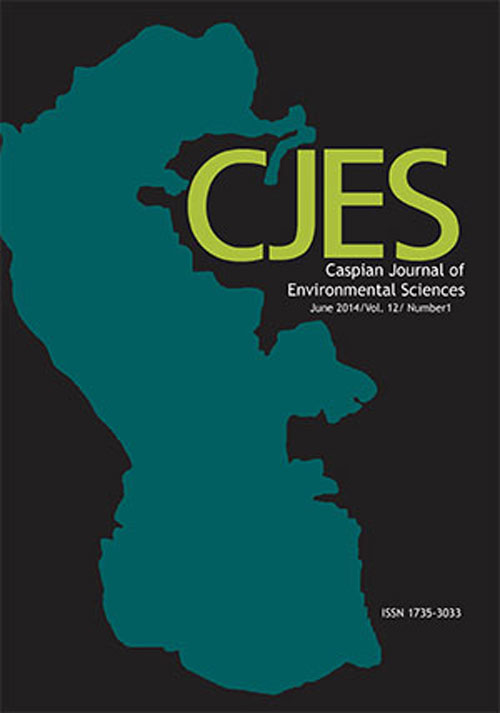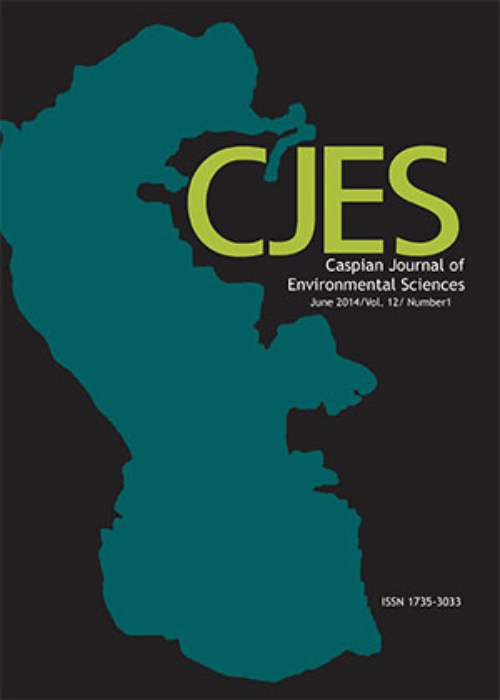فهرست مطالب

Caspian Journal of Environmental Sciences
Volume:15 Issue: 3, Summer 2017
- تاریخ انتشار: 1396/07/25
- تعداد عناوین: 8
-
-
Pages 205-212In this study, we investigated the age-dependent changes in reproductive efficiency of Kutum, Rutilus frisii caught from Shirood River, the Southern Caspian Sea (Mazandaran Province, Iran). Age-dependent reproductive performance of brooders was assayed on two age and sex groups. Results revealed that there were no significant differences in sperm characteristics between age groups. All female characteristics revealed change except relative fecundity between two age groups. The higher fertilization rate (%87) and also survival rate (%91) were found when the 4 year - old males were crossed with 4 year - old females (PKeywords: Kutum, R. frisii, Survival, Reproduction traits, Fertilization
-
Pages 213-222The growing interest on the replacement of synthetic antioxidants with natural ones has directed many research toward the plant-derived raw materials. The special attention is focused on inexpensive or residual sources from food agricultural industries. Fruit peels are valuable wastes obtained from domestic and industrial sources. The potential of fruit wastes as sources of natural antioxidants was explored in the present research. The peels of five kinds of fruits commonly used were obtained from domestic consumption. Antioxidant activity of their separate extract was assessed using DPPH radical scavenging activity and ferric-reducing antioxidant power. Besides, total phenol, flavonoid anthocyanin, protein and soluble sugar contents of the samples were also determined. According to the results, the apple peel extract contained the most content of total flavonoid, soluble sugar, protein and ferric-reducing antioxidant power. The maximum DPPH radical scavenging activity (256.78 ± 4.54 mg AA. g-1 dry weight = DW), total phenol (13.17 ± 0.268 mg of GAE. g-1 DW) and total anthocyanin (0.811 ± 0.024 mg. g-1 DW) were observed in orange peel. This study demonstrated that fruit peels could serve as potential sources of antioxidants in the food and pharmaceutical industries.Keywords: Fruit wastes, DPPH, FRAP, total phenol, secondary metabolites
-
Pages 223-235Anzali Wetland as a listed habitat in Montreux Record, was investigated for the mammal fauna during Jan. 2015 - Jan. 2016. About 165 km of water bodies and 200 km around Anzali Wetland were patrolled, respectively. By applying different methods, such as direct observation, different signs recording, using different sampling traps, nets and camera traps, twenty mammal species were identified from 5 orders and 13 families. While Wild boar, Golden Jackal and Common otter were widely distributed, Common badger, Asiatic wildcat and Jungle cat were observed in some parts of this wetland. Six rodent species were recognized in different parts of the wetland.
Among four identified bat species, Nathusiuss pipistrelle has been reported only from this region in Iran. The most commonly recorded bat species was the Soprano pipistrelle, a species hereto recorded only from two Iranian localities. Two recognized species from order Eulipotyphla; Caspian shrew and a mysterious mole are important due to their narrow geographical distribution range as well as their taxonomic situation. Although there was no quantitative or qualitative data from the past, our results show that the situation of many mammal species are not suitable, and some of them are being increasingly threatened.Keywords: Anzali Wetland, Distribution, Mammals check-list, Iran -
Pages 237-247The objective of this study was to determine the effect of human chorionic gonadotropin (hCG) on sexual maturation, plasma sex steroids (17β-estradiol, E2 and 17α-hydroxy progesterone (17α OHP)) and thyroid hormones (triiodothyronine, T3 and thyroxin, T4) levels in upstream - migrating Caspian lamprey. During the experiment, 36 fish (24 females and 12 males) in spring 2013 and 36 fish (24 females and 12 males) in fall 2013 were collected from the Shirud River estuary in Mazandaran Province, the Southern Caspian Sea during their upstream migration to the freshwater. All fish were injected with hCG at the doses of 1000, 1500 and 2000 IU.kg BW-1. The injection was a two - step process (50% of hormone in each step) by 12 h interval. After the first injection, fish were retained in the cages in the river beds and 24 hours after the second injection, fish were checked for egg and sperm release after mild abdomen pressure. Blood samples were taken for determining sex steroid levels. Results showed that hCG hormone injections caused increase in migration of germinal vesicle in the oocyte of female and sperm release in males. Significant differences were found in the serum E2 and 17α-OHP levels in hCG - injected fish compared to the control. However, no significant differences were found in serum T3 and T4 levels in the hCG - injected fish. According to the results, the appropriate hCG dosage to induce the reproduction acceleration in Caspian lamprey is 1500-2000 IU.kg BW-1.Keywords: Lamprey, Caspian Sea, Induced reproduction, Hormonal changes
-
Pages 249-262Phytoremediation is a promising method for remediation of heavy metals (HMs) contaminated environments. However, the main failures are the limited bioavailabilty of HMs such as lead (Pb) in the soil and/or suppressed plant growth in contaminated sites. These limitations specifically occur in semi-arid zone environments such as calcareous soils. Arbuscular mycorrhizal fungi (AMF) and plant growth-promoting rhizobacteria (PGPR) are known to enhance plant growth and survival in heavy metal contaminated soils. The main objective of this study was to evaluate enhancing soil Pb phytoremediation by Onopordum acanthium through inoculation with some AMF and PGPR. A calcareous soil was selected and spiked uniformly with different concentrations of Pb (0, 250, 500 and 1000 mg Pb kg-1 soil). The contaminated soils were then sterilized and subsequently inoculated with AMF and PGPR in which O. acanthium seeds were grown. Results indicated that inoculation of AMF and PGPR increased bioavailable Pb, shoot and root dry matter yield and Pb uptake by O. acanthium. Microbial inoculation increased the amount of Pb extracted by O. acanthium up to 2-11 times higher than the control. The amount of Pb stabilized by roots of O. acanthium was 1.75-2.71 and 1.25-1.53 times higher than control for AMF and PGPR treatments, respectively. Therefore, it could be concluded that inoculation with AMF and PGPR can be used as a promising strategy for enhancing the phytoremediation of Pb-contaminated soils by O. acanthium.Keywords: Heavy metals, Phytoextraction, Phytostabilization, Soil microorganisms, Wild plants
-
Pages 263-270Adsorbent properties and aqueous characteristics are very important parameters in the removal efficiency (RE) of environmental pollutants. The main goal of this study was to investigate the effects of pH, particle size and porosity of raw rice husk and its silica on removing lead and hexavalent chromium (Cr) from aqueous solution. The raw rice husk was collected from north of Iran and the rice husk silica was prepared at 800ºC after acid leaching. The effects of the adsorbent particle sizes (0.07-0.1, 0.1-0.5, 0.5-1.0 and 1.0-1.5 mm), porosity and pH from 2 to 8 were investigated by varying any of the process variables while keeping the other variables constant (adsorbent dosage = 1.5 g.l-1, contact time = 60 min, chromium and lead initial concentration= 5 mg.l-1). The results of this study showed that the RE of Cr is intensively pH - dependent. Using 1.5 g.l-1 adsorbents, particle size = 0.5 - 1.0 mm, 5.0 mg.l-1 initial concentration of Cr and 60 min contact time, the maximum RE obtained by raw rice husk and its silica at pH 2 were up to 98.8 and 88.4%, respectively. However, at the same condition with changing pH (pH 7), the maximum RE decreased up to 69.4 and 60.4%, respectively. Moreover, a positive strong significant correlation was detected between decreasing the adsorbents particle sizes and lead removal efficiency in the two adsorbents (pKeywords: Hexavalent chromium, Lead, Particle size, Removal efficiency, Rice husk silica
-
Pages 271-284Climate change is known as one of the most important environmental challenges. Sequestration of carbon in terrestrial ecosystems is a low-cost option that may be available in the near-term to mitigate increasing atmospheric CO2 concentrations, while providing additional benefits. In this study, we estimated the effects of planting density and grazing intensity on the potential of Atriplex canescens for carbon sequestration in a rangeland in Qazvin Province, Iran. The experimental design consisted of a randomized block design, including two planting densities (2 × 2m and 4 × 4m) and four grazing intensity treatments simulated by different plant pruning intensities. We observed no significant difference between the rate (%) of organic carbon in the treatments of density, grazing intensity, and their interaction in the 0-30cm and 30-80cm soil layers. Between the treatments of height pruning, control (no pruning) and light grazing, had the highest total biomass and total carbon. The total biomass carbon content of 2370 kg m-2 in the 2×2m treatment was about twice as much that of 4x4m treatment. These findings can be useful in rangeland management plans.Keywords: Carbon sequestration, Biomass, Atriplex canescens, Grazing intensity, Planting density
-
Pages 285-294Isoelectric solubilization /precipitation (ISP) process was used to isolate protein from muscles of Prussian carp, Carassius gibelio (Bloch, 1782). Fish protein and lipid were recovered from whole gutted Prussian carp using acidic and basic isoelectric solubilization/precipitation followed by assaying amino acid and fatty acid profile. Essential amino acids content in acidic and basic pH treatment of ISP of Prussian carp were 216.6 and 218.7 mg.g-1, respectively. Results showed that identified amino acids in Prussian carp protein isolated by ISP method, could meet all needs of adults, but a supplementary protein must be used for children. Limiting amino acids in both acidic and basic treatments were methionine and cysteine. Nineteen fatty acids of saturated (SFA), monounsaturated (MUFA) and polyunsaturated (PUFA) groups were identified in lipid recovered in isoelectric solubilization/precipitation process. Total PUFA in basic treatment was noticeably higher than in acidic one. N-3/n-6 ratio in basic pH treatment was also higher than in acidic one.Keywords: Prussian carp, Amino acid profile, Fatty acid profile, Isoelectric solubilization, precipitation


